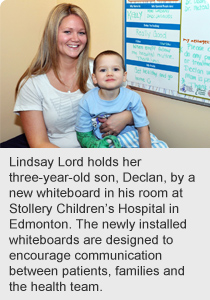
October 22, 2012
Story by Sharman Hnatiuk; Photo Courtesy Heather McIntyre/Metro
Lindsay Lord has a request for health care professionals at the Stollery Children’s Hospital in Edmonton.
“It’s always been very important for me that no procedures be done on Declan without me present,” says Lord, whose three-year-old son Declan makes regular visits to the Stollery for a spinal cord tumour.
Now that request, and other questions she may have, can be written down where all hospital staff can see them.
The Stollery Children’s Hospital aims to encourage communication and familiarity between patients, families and health professionals with the recent installation of dry-erase whiteboards in all hospital rooms. The whiteboards include spaces to write the names of the patient and members of the family and care team. Family members are also encouraged to leave their questions and concerns on the whiteboard, so they can be addressed.
Lord says the whiteboards immediately improved her family’s health care experience and her own peace of mind.
“Now here is a space for me to write my request on a board that everyone looks at the second they enter the room,” she says. “People read that and they wait for me. It’s comforting to know that everyone is using the board and is on the same page.”
Lord says there are other benefits, too.
“Half the time you forget who the nurses are and now all I have to do is look up and see their names,” she says. “I have been called by my first name more during this stay than ever before.”
Sandra Caligiuri, a clinical nurse educator at the Stollery, admits the addition of whiteboards in patient rooms is a simple modification but one that provides a sense of reassurance for families, especially when they cannot be at bedside.
“Many families are in shock when they arrive on the unit for the first time. They don’t know the health providers coming in and out of the room, they don’t understand what’s happening with their child, and they have no sense of empowerment,” says Caligiuri.
“The boards inform parents who is taking care of their child and who can answer their questions. It gives families some control back.”
More than 220 whiteboards have been installed. They are near all beds at Stollery Children’s Hospital, including those in the emergency department. They are also in the neonatal intensive care units at the Royal Alexandra Hospital and the University of Alberta Hospital; the pediatric intensive care unit at the University of Alberta Hospital; and the inpatient unit at the Glenrose Rehabilitation Hospital.
“This way, there will be consistency for patients and families when they transfer between units and facilities,” says Caligiuri.
The project was spearheaded by the Stollery Family Centred Care Council, which is comprised of families, front-line staff, physicians and management. The council heard about the positive effect of whiteboards in hospitals across Canada and abroad, and before bringing the idea to Edmonton, feedback was sought from local pediatric patients and their families; front-line nursing staff; social workers; and members of AHS Child Life Services.
“Knowing the name of your child’s nurse, or being able to leave a message for a physician if you are going to be away from the room, is a simple yet effective way to encourage communication between patients, families and staff,” says Marcel Panas, Family Centred Care co-ordinator.
“The ongoing dialogue on the board can inspire a sense of partnership and provides opportunities for families to become more engaged in the day-to-day care of their child.”
The $27,000 project was funded by the President’s Choice Children’s Charities through the Stollery Children’s Hospital Foundation, and by the Nancy Liebermann Fund through The Friends of University Hospitals.